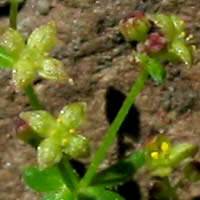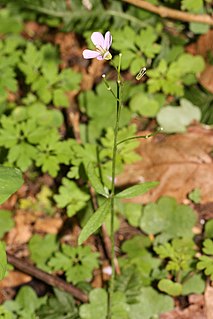
Helianthus is a genus comprising about 70 species of annual and perennial flowering plants in the daisy family Asteraceae. Except for three South American species, the species of Helianthus are native to North America and Central America. The common names "sunflower" and "common sunflower" typically refer to the popular annual species Helianthus annuus, whose round flower heads in combination with the ligules look like the sun. This and other species, notably Jerusalem artichoke, are cultivated in temperate regions and some tropical regions as food crops for humans, cattle, and poultry, and as ornamental plants. The species H. annuus typically grows during the summer and into early fall, with the peak growth season being mid-summer.

Cornus nuttallii, the Pacific dogwood or mountain dogwood, is a species of dogwood native to western North America from the lowlands of southern British Columbia to the mountains of southern California, with an inland population in central Idaho. Cultivated examples are found as far north as Haida Gwaii. It is a small to medium-sized deciduous tree, reaching 10–25 m tall.

Helianthus nuttallii, or Nuttall's sunflower, is a species of sunflower native to northern, central, and western North America, from Newfoundland west to British Columbia, south to Missouri, New Mexico, and California.

Acanthomintha duttonii is a species of annual plant endemic to San Mateo County, California in the family Lamiaceae. It is commonly called San Mateo thornmint and is found growing on serpentine soils near the Crystal Springs Reservoir in a six-mile (10 km) long strip on the east side of Montara Mountain at elevations of approximately 150 to 300 meters.

Lagophylla is a small genus of flowering plants in the sunflower family. The genus is native to western North America, especially California.

Bromus secalinus is a species of bromegrass known as rye brome. The specific epithet secalinus is Latin, meaning "rye-like". The fruits are hard, rounded glumes that appear superficially similar to the rye grain, which gives the brome its common and scientific name. The grass has a diploid number of 28.

Elodea nuttallii is a species of waterweed known by the common name western waterweed or Nuttall's waterweed. This is a perennial aquatic plant which is native to North America where it grows submersed in lakes, rivers, and other shallow water bodies. It is also found in Eurasia, where it is commonly weedy; it is not known as a weed species in its native range. It is sometimes used as an aquarium plant.

Garrya fremontii is a species of flowering shrub known by several common names, including California fever bush, bearbrush, and Frémont's silktassel. Both the latter name, and the plant's specific epithet are derived from John C. Frémont.

Helianthus gracilentus is a species of sunflower known by the common name slender sunflower. It is native to central and southern California and Baja California, where it is a member of the dry wildfire-prone chaparral ecosystem.

Helianthus maximiliani is a North American species of sunflower known by the common name Maximilian sunflower.

Galium nuttallii is a species of flowering plant in the coffee family known by the common names San Diego bedstraw and climbing bedstraw. It is native to the coast and coastal Peninsular and western Transverse Ranges of southern California and Baja California, where it is a member of chaparral and pine woodland plant communities. It is also found on the Channel Islands and on the mainland as far north as Santa Barbara County

Astragalus nuttallii is a species of milkvetch known by the common name Nuttall's milkvetch. It is native to California and Baja California, where it grows in the sandy soils of coastal habitat. This is a perennial herb forming thick, tangled clumps of hairy to hairless stems up to a meter in length. The abundant leaves are up to 17 centimeters in length and made up of many oval-shaped leaflets. The inflorescence is a large, dense body of up to 125 flowers, each around 1 to 1.5 centimeters long. The flowers are dull cream-colored and sometimes purple-tinted. The fruit is an inflated legume pod up to 6 centimeters long which dries to a papery texture and contains many seeds in its single chamber. One variety of this species, the ocean bluff milkvetch is endemic to the Central Coast of California.

Bromus catharticus is a species of brome grass known by the common names rescuegrass, grazing brome, prairie grass, and Schrader's bromegrass. The specific epithet catharticus is Latin, meaning cathartic. The common name rescuegrass refers to the ability of the grass to provide forage after harsh droughts or severe winters. The grass has a diploid number of 42.

Calochortus amabilis is a species of the genus Calochortus in the family Liliaceae. It is also known by the common names Diogenes' lantern, yellow globe-tulip, golden globe-tulip, yellow globe lily, golden fairy lantern, golden lily-bell, Chinese lantern, and short lily.

Cardamine nuttallii is a species of cardamine known by the common name Nuttall's toothwort. It is native to western North America from British Columbia to California, where it grows in moist mountain habitats.

Leptosiphon nuttallii is a species of flowering plant in the phlox family known by the common name Nuttall's linanthus.

Minuartia nuttallii is a species of flowering plant in the family Caryophyllaceae known by the common names Nuttall's sandwort and brittle sandwort.

Helianthus petiolaris is a North American plant species in the sunflower family, commonly known as the prairie sunflower or lesser sunflower. Naturalist and botanist Thomas Nuttall was the first to describe the prairie sunflower in 1821. The word petiolaris in Latin means, “having a petiole”. The species originated in Western United States, but has since expanded east. The prairie sunflower is sometimes considered a weed.

Atriplex nuttallii, also known as Nuttall's saltbush, is native to central and western North America. It has been treated by some botanists as a synonym of Atriplex canescens.
Helianthus nuttallii subsp. parishii is a subspecies of the species Helianthus nuttallii in the genus Helianthus, family Asteraceae. It is also known by the common names Los Angeles sunflower and Parish's sunflower. This subspecies has not been seen, in the wild or in cultivation, since 1937.


















